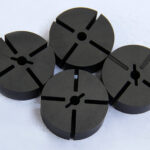Recently, a research team from the Okinawa Institute of Science and Technology Graduate University in Japan achieved a breakthrough in the field of macroscopic suspension systems, successfully developing a graphite rotor that can freely rotate and levitate with near-zero friction. This achievement overcomes the long-standing challenge of eddy current damping that has hindered the development of macroscopic suspension systems, opening up new avenues for high-precision measurement technology and quantum physics research. The research results have been published in the internationally renowned journal Nature Communications, garnering widespread attention in the engineering and physics communities.
Engineering Significance & Challenges of Levitation
In engineering and scientific research, achieving a “weightless” levitation state is an ideal method for isolating objects from external interference and improving measurement accuracy. In particular, in the design of precision instruments and sensors, levitated rotors, because they can significantly reduce friction and damping caused by mechanical contact, have become key components for measuring physical quantities such as torque, angular momentum, gravity, and air pressure. However, conventional suspension systems, at macroscopic scales, struggle to avoid energy loss and signal interference caused by contact support, severely limiting their application in highly sensitive equipment.
Unlike microscale levitation systems that rely on complex optical or electric field control, macroscopic magnetic levitation systems offer advantages such as simple structure, strong environmental adaptability, and the absence of extreme cryogenic conditions, allowing for stable operation at room temperature. However, such systems have long been plagued by the “eddy current damping” effect. When a conductor moves in an inhomogeneous magnetic field, it induces circular currents, which in turn generate a magnetic field that resists motion, creating a damping force similar to “magnetic friction.” This causes continuous energy dissipation in the system and introduces additional noise, seriously affecting the purity of the measurement signal and system stability.

Innovative Design of the Graphite Rotor System
Based on the principle of diamagnetic levitation, the research team used a graphite disc approximately 1 cm in diameter as the rotor material and combined it with rare-earth permanent magnets to create a levitation magnetic field. Graphite, a material with significant diamagnetic properties, produces a magnetization effect in the opposite direction of the external magnetic field in a strong magnetic field, thereby achieving stable static levitation. Furthermore, through precision machining and system optimization, the team ensured a high degree of axisymmetry between the rotor and the magnetic field.
Through systematic experimental testing and theoretical modeling, the research confirmed that under ideal axisymmetric conditions, the rotor does not induce significant eddy current response during rotation, eliminating the impact of eddy current damping on the system’s dynamic performance. This discovery, based on a physical mechanism, breaks through the performance bottleneck of traditional macroscopic levitation systems and provides a theoretical basis and engineering implementation path for achieving near-frictionless rotor motion.
Engineering Applications & Future Development
This graphite rotor system is not only of great significance in fundamental physics research but also demonstrates broad potential in multiple engineering applications. First, in inertial sensing and navigation systems, this type of freely floating rotor can serve as a core component of high-precision gyroscopes, significantly improving the sensitivity and stability of angular velocity measurements. This makes it suitable for high-end inertial navigation applications in aerospace, unmanned systems, and precision manufacturing.

Second, as system dimensions continue to shrink to millimeter or even micron scales, this technology is expected to drive the development of a new generation of highly sensitive sensors, such as high-performance devices for microforce measurement, gravity gradient detection, and low-frequency vibration monitoring. Its near-zero friction significantly reduces the system’s noise floor, providing a cleaner physical environment for weak signal detection.
Furthermore, under cryogenic conditions, this system can be further expanded to serve as a research platform for macroscopic quantum phenomena. By slowing the rotor’s speed, the system can potentially enter the quantum ground state, providing an unprecedented experimental platform for exploring cutting-edge scientific questions such as quantum entanglement, vacuum gravitational effects, and quantum superposition states of macroscopic objects. This will not only deepen our understanding of the fundamental laws of quantum mechanics but also potentially catalyze the development of next-generation sensing and information processing technologies based on quantum effects.
Conclusion: Towards Zero-Friction Systems
The progress made by a Japanese research team in graphite rotor suspension technology marks a key step forward in both the theory and engineering practice of macroscopic suspension systems. By fundamentally addressing the issue of eddy current damping, this research not only advances the concept of “zero-friction” suspension rotors but also lays a solid foundation for the construction of high-precision engineering systems and macroscopic quantum experimental platforms. With the further integration of materials science, precision engineering, and low-temperature physics, this latest technology is expected to continue to unleash its innovative potential in fields such as high-end instrumentation, quantum technology, and space exploration.










